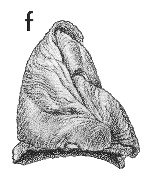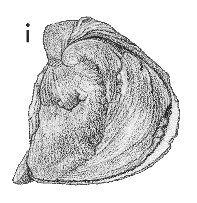
Revised descriptions of New Zealand Cenozoic Mollusca from Beu and Maxwell (1990)

 | Revised descriptions of New Zealand Cenozoic Mollusca from Beu and Maxwell (1990) | 
|
  (Pl. 13f): GS3600, F46/f8492, Mataura River, near Brydone, Southland, Waitakian (GNS) |
  (Pl. 13i): GS3600, F46/f8492, Mataura River, near Brydone, Southland, Waitakian (GNS) |
Beu & Maxwell (1990): Chapter 10; p. 152; pl. 13 f, i.
Synonymy: Chama albida Lamarck 1819, p. 96; Chama ("Camostrée") hemicardium de Roissy in Blainville 1825 (in 1825-27), p. 632; Cleidothaerus chamoides Stutchbury 1830, p. 98; Chamostrea crassa Tate 1885, p. 228; Cleidothaerus maorianus Finlay 1926c, p. 474; Chamostrea albida
Type species (as C. chamoides) of Cleidothaerus Stutchbury, 1830
Classification: Cleidothaeridae
Description: Rather large for superfamily (height 40-70 mm), robust, trigonal, both valves distinctly coiled; strongly inequivalve, right valve deep, markedly inequilateral with a large, strongly defined anterior area by which it is attached to rock or shells; left valve flat or weakly convex, more equilateral than right valve, with a curved sulcus running from apex to ventral margin. Prodissoconch triangular, closely resembling that of Myochama (Odhner 1917, p. 36). Sculpture on unattached part of right valve and on left valve posterior to median sulcus of growth lines and ridges, but typically much more irregular anterior to sulcus. Interior nacreous. Hinge of left valve with a single tubercular tooth in front of a deep resilial pit that extends under the umbo; right hinge with a shallow socket projecting somewhat into shell cavity, resilial pit larger than in left valve. Lithodesma weakly coiled. Anterior adductor muscle scar more elongate than posterior scar. Pallial sinus very shallow or obsolete.
Comparison: No significant differences can be discerned between the Australian and New Zealand shells or between the fossil and modern specimens. The occurrence of a clearly distinct, internally ridged species of Cleidothaerus in northern Western Australia (C. pliciferus Odhner 1917, p. 34) provides circumstantial evidence that the morphologically identical New Zealand and southern Australian shells are conspecific, but this is one of several examples of apparently conspecific taxa on the two sides of the Tasman Sea where diagnostic characters are simply lacking in the shells, and the taxonomy will remain uncertain until the anatomy is examined and the genetic composition is studied (others include Scutus antipodes, Anomia trigonopsis, and Pododesmus (Monia) zelandicus).
The priority of the generic names proposed for the single genus in this family has long been debated. The most complete synonymy published is that of Lamy (1936, pp. 322-323), but the data in the major nomenclators (Neave 1939; Sherborn 1925) and the note by Iredale (1939) show that Lamy's usage of Chamostrea is invalid. Roissy (1805) did not include either Chamostrea or the vernacular "camostrée" in his section on Mollusca in Buffon's natural history, despite the inclusion of this reference by Hermannsen (1846) and several later authors. The name was first published by Blainville (1825, in 1825-1827, p. 632), still as the vernacular "Camostrée", attributed to de Roissy. The latinised name Camostraea appears to have been published first by Deshayes (1830, p. 178) where, however, it is a genus without species, merely a Latinisation of the vernacular name in Blainville (1825); Deshayes stated that he did not know the genus and could not see why Roissy separated it from Chama. [We have been unable to check on the reference to Chamostrea in Férussac, "Bull. sc. nat. tom. 24, p. 370" (presumably also published about 1830) listed by Herrmannsen (1846, p. 221), and this is possibly a valid earlier Latinisation of the name].
The name Cleidothaerus Stutchbury had, in the meantime, been proposed in February 1830 (Sherborn 1925, p. 1357) and has been accepted as the valid name for the genus by most workers after it was adopted by Iredale (1915). Only the year of publication is known for Deshayes (1830) (Sherborn and Woodward 1906, p. 579) and it should, therefore, be dated as 31 December 1830, and so Cleidothaerus is undoubtedly the earlier name, and we continue its usage. Two different references to the publication of Chamostrea by Gray in 1840 have been published: (1) Sherborn (1925, p. 1210) cited "Syn. Cont. Brit. Mus., ed. 42, 1840, 136 & 150", but noted that the name is a nomen nudum in this publication; (2) Neave (1939, p. 668) and Vokes (1980, p. 207) both cited "1840, Ann. Mag. Nat. Hist., 4, 306," but careful checking of this volume (actually "The Magazine of Natural History", vol. 4, 1840) showed that it does not contain any papers by Gray, and this is yet another fictitious reference in the Cleidothaerus saga. The first valid publication of Chamostrea appears to have been by Herrmannsen (1846, p. 221), as was also concluded by Keen (in Moore 1969, p. N844).
The family name Chamostreidae Fischer (1887, in 1880-1887, p. 1160) has priority over Cleidothaeridae Hedley, 1918, but as Cleidothaeridae had "won general acceptance" long before 1961, it was conserved under ICZN (1985 ed.) Article 40(b) by Beu & Maxwell (1990, p. 154).
This unusual bivalve has a similar habit and functional morphology to those of Chama (Pl. 18d, g) (Odhner 1917; Morton 1974) but belongs in a different subclass. Runnegar (1974, p. 934) suggested that Cleidothaerus was derived from "an unspecialised verticordiid" but most workers include it in the Pandoroidea near the Pandoridae and Myochamidae. Living specimens of Cleidothaerus albidus are cemented to rocks, shells or algal holdfasts from high tide level down to a few metres. In New Zealand they are most common attached to rocks, on a very exposed coast near Kawhia Harbour and on a sheltered shore in the outer part of Manukau Harbour.
Distribution: Waitakian-Recent; Chatton Formation, Mataura River, near Brydone, Waitakian (rare); Target Gully Shellbed, Oamaru; Castlecliff, Wanganui; Hauriri Terrace cover, Waipipi, Waverley Beach, oxygen isotope stage 5a (common); living in the North Island (type of C. maorianus from Kawhia Harbour) to northernmost South Island and the Chatham Islands. The type of Chama albida is a Recent specimen from Tasmania, and C. hemicardium and C. chamoides are based on Recent shells from southern Australia. C. crassa was described from "Table Cape", i.e., Fossil Bluff, near Wynyard, N Tasmania (Longfordian, Early Miocene), but Tate himself (Tate 1887a, p. 149) quickly realised it is part of the variation of C. albidus.
Cite this publication as: "A.G. Beu and J.I. Raine (2009). Revised
descriptions of New Zealand Cenozoic Mollusca from Beu and Maxwell (1990). GNS
Science miscellaneous series no. 27."
© GNS Science, 2009
ISBN
978-0-478-19705-1
ISSN 1177-2441
(Included with a PDF facsimile file
copy of New Zealand Geological Survey Paleontological Bulletin 58 in CD version
from: Publications Officer, GNS Science, P.O. Box 30368 Lower Hutt, New
Zealand)